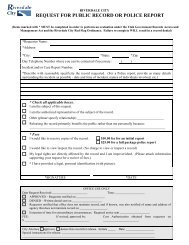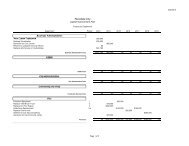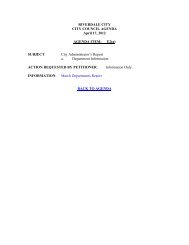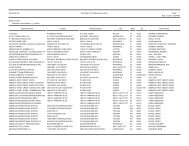Weber River Flood Damage Assessment - Riverdale City
Weber River Flood Damage Assessment - Riverdale City
Weber River Flood Damage Assessment - Riverdale City
You also want an ePaper? Increase the reach of your titles
YUMPU automatically turns print PDFs into web optimized ePapers that Google loves.
<strong>River</strong>dale <strong>City</strong> 2011 <strong>Flood</strong> <strong>Assessment</strong> October 13, 2011<br />
was largely an agricultural community with farmlands dominating the landscape (Figure 1). While the<br />
river was somewhat constrained by the railroad and Highway it was free to migrate across much of the<br />
valley. Historic flow paths are evident throughout the 1953 photo. Historic channel alignments appear<br />
as dark oxbow shaped areas, which are older alignments that have become vegetated, or light oxbow<br />
shaped areas, which are more recent (see Figure 3). These historic channels indicate that the <strong>Weber</strong><br />
<strong>River</strong> may have had a meander belt width in excess of 1500ft. Analysis of Figure 3 indicates that the<br />
<strong>Weber</strong> <strong>River</strong> had a meander belt width over 1000 ft wide in 1953. In this active system as the main<br />
channel aggrades and a new main channel is formed the old channel is still available to convey water at<br />
high flows. These overflow channels relieve pressure within the main channel. Shear stress in the main<br />
channel is thus reduced resulting in less bank erosion than if all flood flow remained in the main<br />
channel. Loss of these overflow side channels results in increased pressure in the main channel causing<br />
excessive bank erosion and down cutting (degradation) of the channel bed.<br />
Although riparian areas represent less than one percent of the land within Utah, they are among the<br />
most diverse and densely used wildlife habitat in this region. Animals including migratory songbirds,<br />
deer, elk and amphibians rely on these riparian corridors for food, cover, breeding habitat and<br />
movement corridors. Riparian areas also provide many important functions to humans, from recreation<br />
to providing clean and abundant water, to reducing flooding. Disturbance of a riparian area also has a<br />
cause and effect that changes the characteristic of these environments. The aggradation of historic flow<br />
paths and the resultant migration of the river to new flow paths create a mosaic of diverse habitat.<br />
Some remnant channels remain open, filling with water and becoming oxbow lakes or wetlands. Newly<br />
exposed point bars provide new habitat for riparian plants. Diversity is one of the most important<br />
measures of habitat quality.<br />
Riparian forest species such as Fremont Cottonwoods (Populus fremontii) have evolved with channel<br />
migration as a critical component of their life cycle. High flows during spring runoff mobilize<br />
sediments at the edge of active channels and create point bars. Additionally overbank flows may scour<br />
areas of vegetative cover and mulch. These exposed areas are essential for cottonwood establishment.<br />
The cottonwood seeds are deposited in these areas which remain wet as the river recedes. The seeds<br />
germinate at this time and grow a tap root that follows the water table as the hydrograph declines,<br />
creating new riparian forests. These forests in turn capture sediment and retain floods. Many other plant<br />
and animal species are similarly adapted to this dynamic environment.<br />
4






